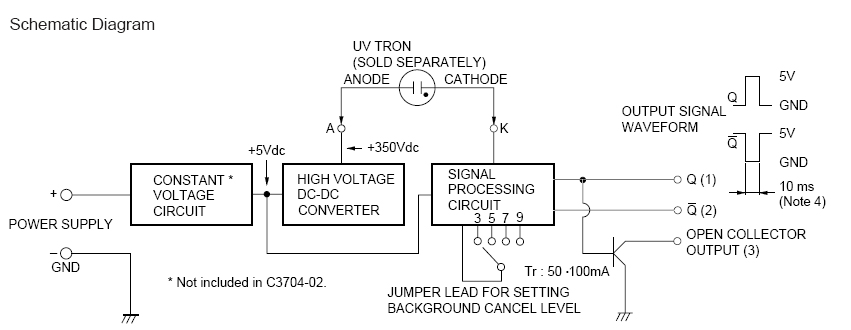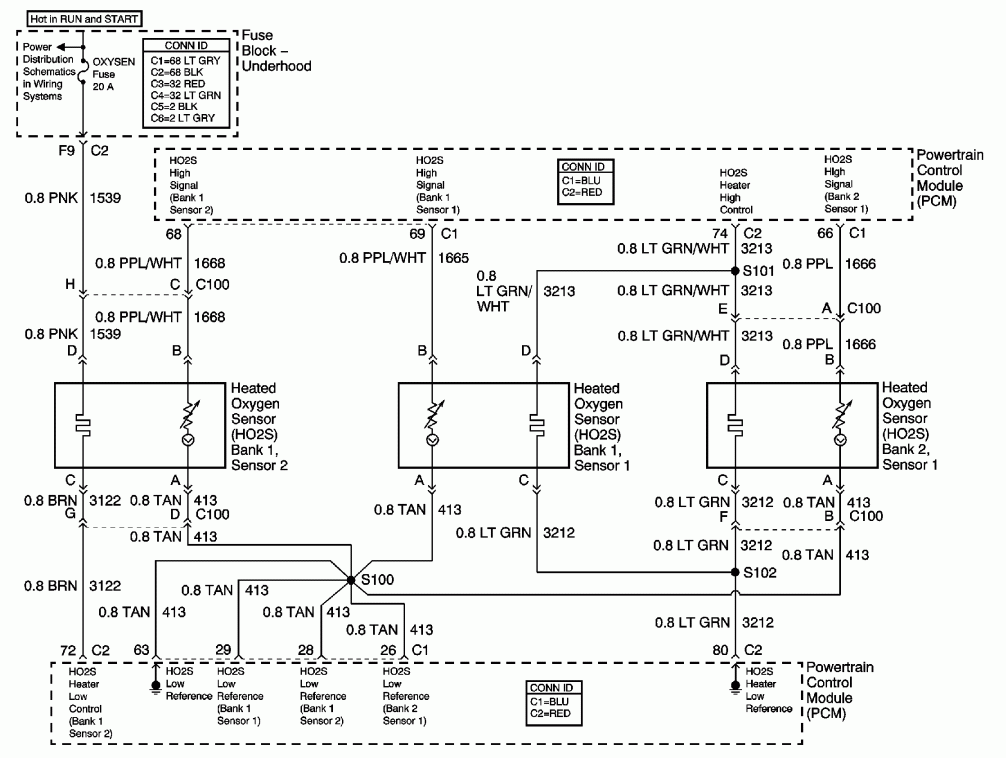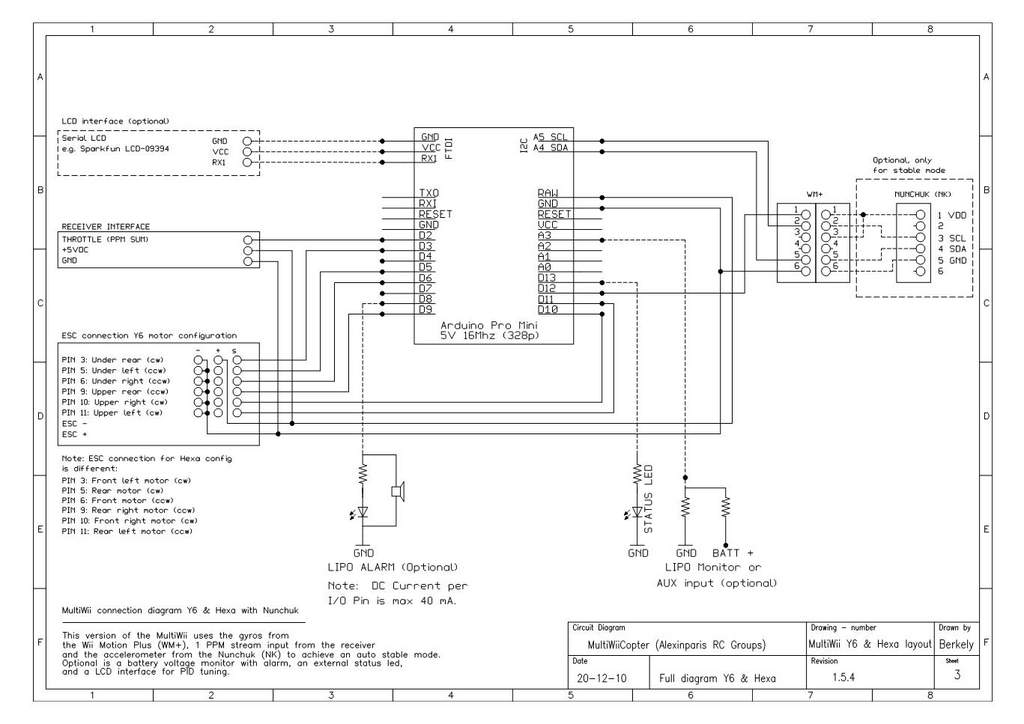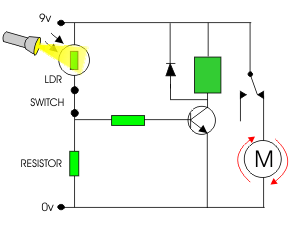
Flame Sensor

The UV TRON flame sensor, manufactured by Hamamatsu Photonics in Japan, is an ultraviolet light detector with a spectral sensitivity range of 185 nm to 260 nm. It is completely insensitive to visible and infrared light, eliminating the need for optical visible-cut filters, which simplifies its usage. Despite its compact size, it possesses wide angular sensitivity, allowing it to detect weak ultraviolet radiation emitted from flames, such as those from a cigarette lighter, at distances of up to 5 meters. This sensor is particularly suitable for applications in flame detection and fire alarm systems. In comparison to smoke detectors, the UV TRON flame sensor does not provide information on the size of the fire, making it ideal for environments where even small flames must be detected, such as in paper manufacturing facilities. Common applications for this sensor include flame detectors for gas and oil lighters, fire alarms, combustion monitors for burners, ultraviolet leakage inspection, discharge detection, and ultraviolet switching. An illustrative example of its application is in the Trinity Firefighting Robot Contest, where a robot is tasked with navigating a model floor plan to locate and extinguish a candle representing a flame source. The detection mechanism of the sensor is straightforward: when ultraviolet rays from an open flame strike the cathode leg of the sensor, photoelectrons are generated. The flow of these electrons towards the anode, combined with the applied voltage, creates an electric field that intensifies over time, ionizing the gas inside the bulb and increasing electron flow. Eventually, this results in a discharge between the cathode and anode, leading to a voltage drop. The UV TRON driving circuit board supplies voltage to the tube, monitors the discharge effect, and regulates the voltage drop, conditioning the signal to provide pulse outputs to users. The sensor's effectiveness stems from its narrow wavelength sensitivity, which allows it to ignore common light sources like sunlight and tungsten light, although it may still be susceptible to false detections from other UV light sources such as halogen lights. Additionally, the sensor does not need to be directly facing the light source, as ultraviolet rays can reflect off surfaces, enhancing its ability to detect flames within a confined space. The sensor has a substantial viewing range, offering nearly ±45° horizontal and vertical sensitivity rather than a focused sensing range. The default jumper lead for background cancellation is set to 3, ensuring that if the UV TRON bulb generates only 3 pulses every two seconds, the drive board will disregard these signals and not produce pulse outputs. The power supply input pin accommodates unregulated voltages between 10 to 30 VDC.
The UV TRON flame sensor's design and operational principles are critical for applications requiring reliable flame detection in various environments. Its selective sensitivity to ultraviolet light allows for effective monitoring without interference from visible light sources, making it suitable for industrial applications where safety is paramount. The sensor's ability to detect flames even from oblique angles enhances its versatility, as it can efficiently monitor large areas. In integration with control systems, the pulse output can be used to trigger alarms or activate suppression systems, ensuring rapid response to potential fire hazards. The robustness of the UV TRON sensor, combined with its ease of implementation, makes it an invaluable component in fire safety solutions across diverse sectors, including manufacturing, oil and gas, and robotics. Furthermore, its adaptability to different voltage inputs allows for seamless integration into existing systems, enhancing its appeal for engineers and developers in the field of fire detection technology.A flame sensor (UV TRON) made by HAMAMATSU PHOTONICS, Japan, is an ultraviolet light detector. It has a narrow spectral sensitivity of 185 nm to 260 nm, being completely insensitive to visible and infrared light. Unlike semiconductor detectors, it does not require optical visible-cut filters, thus making it easy to use.
In spite of its small size, it has wide angular sensitivity and can reliably and quickly detect weak ultraviolet radiations emitted from flame (eq. it can detect the flame of a cigaret lighter at a distance of 5 meters). The sensor is well suited for use in flame detectors and fire alarms. Compare with the other fire alarm, such as smoke detector, I found that this flame detector sensor can not distinguish how big the fire it is.
So I think it more suitable to put in the place which can not even allow a small flame, for example, paper manufacturing factory. Here are some more common applications for the sensor may include, Flame detectors for gas/oil lighters and matches Fire alarms Combustion monitors for burners Inspection of ultraviolet leakage Detection of discharge Ultraviolet switching Such as the pictorial example from HAMAMATSU: Another exemplar use of the sensor is a competition robot in Trinity Firefighting Robot Contest from Ohio Northern University.
The robot is to navigate through a model floor plan of four rooms where a candle representing a flame source is randomly placed, locate the candle, extinguish it, and return safely to its starting location. The sensor`s theory of detection is actually fairly simple. When ultraviolet rays such as those from an open flame hits the cathode leg of the sensor, electricity or more specifically, photoelectrons, is generated.
When the electrons flow toward the anode leg of the sensor combining the applied voltage to the sensor, an electric field is generated and grows stronger over time. This process beings to ionize the enclosed gas inside the bulb and thereby creating more flow of electronics like a tsunami wave building up its energy as it get closer to shore.
And finally a discharge occurs like an avalanche effect between the cathode and anode that in turn, result in a voltage drop. The UV TRON driving circuit board essentially provides the supplying voltage to the tube, look for the discharge effect, and regulate the voltage drop.
Then it conditions the signal and provides pulses signal outputs to the users. Here is the operating theory diagram I drew ! The effectiveness of the UV TRON sensor lies in its ability to sense a narrow range of light source wavelength. It is this ability to sense light source between 185 nm and 260 nm below other common light sources like the sunlight and tungsten light allows the sensor to immune to such noises .
However, there are still other sources of UV light that can cause false detection. For example, Halogen lights such as low-voltage home lighting, torchier lights, and lights on video cameras. Another advantage of its ability to sense ultraviolet rays means it does not need to directly facing the light source.
Ultraviolet ray bounces like other lights thus it can bounce off walls or other surfaces to come back to the sensor to be picked up. Thus a flame sensor has a great potential to detecting a flame source anywhere inside a confined space within the detecting range of the sensor.
The viewing ranges of the sensor shows how the sensor has a large range of sensitivity, or a nearly ±45o horizontal and vertical viewing range rather than a narrow focused sensing range directly in front of the sensor. The jumper lead for background cancellation is default to 3. It is set such that if UV TRON bulb generates only 3 pulses per every two seconds, the drive board ignores these signals and provides no pulse outputs.
It can be set to higher step at 5, 7, or 9. The power supply input pin is for unregulated power between 10 to 30 Vdc. If a reliable regulated 5 Vdc po 🔗 External reference
The UV TRON flame sensor's design and operational principles are critical for applications requiring reliable flame detection in various environments. Its selective sensitivity to ultraviolet light allows for effective monitoring without interference from visible light sources, making it suitable for industrial applications where safety is paramount. The sensor's ability to detect flames even from oblique angles enhances its versatility, as it can efficiently monitor large areas. In integration with control systems, the pulse output can be used to trigger alarms or activate suppression systems, ensuring rapid response to potential fire hazards. The robustness of the UV TRON sensor, combined with its ease of implementation, makes it an invaluable component in fire safety solutions across diverse sectors, including manufacturing, oil and gas, and robotics. Furthermore, its adaptability to different voltage inputs allows for seamless integration into existing systems, enhancing its appeal for engineers and developers in the field of fire detection technology.A flame sensor (UV TRON) made by HAMAMATSU PHOTONICS, Japan, is an ultraviolet light detector. It has a narrow spectral sensitivity of 185 nm to 260 nm, being completely insensitive to visible and infrared light. Unlike semiconductor detectors, it does not require optical visible-cut filters, thus making it easy to use.
In spite of its small size, it has wide angular sensitivity and can reliably and quickly detect weak ultraviolet radiations emitted from flame (eq. it can detect the flame of a cigaret lighter at a distance of 5 meters). The sensor is well suited for use in flame detectors and fire alarms. Compare with the other fire alarm, such as smoke detector, I found that this flame detector sensor can not distinguish how big the fire it is.
So I think it more suitable to put in the place which can not even allow a small flame, for example, paper manufacturing factory. Here are some more common applications for the sensor may include, Flame detectors for gas/oil lighters and matches Fire alarms Combustion monitors for burners Inspection of ultraviolet leakage Detection of discharge Ultraviolet switching Such as the pictorial example from HAMAMATSU: Another exemplar use of the sensor is a competition robot in Trinity Firefighting Robot Contest from Ohio Northern University.
The robot is to navigate through a model floor plan of four rooms where a candle representing a flame source is randomly placed, locate the candle, extinguish it, and return safely to its starting location. The sensor`s theory of detection is actually fairly simple. When ultraviolet rays such as those from an open flame hits the cathode leg of the sensor, electricity or more specifically, photoelectrons, is generated.
When the electrons flow toward the anode leg of the sensor combining the applied voltage to the sensor, an electric field is generated and grows stronger over time. This process beings to ionize the enclosed gas inside the bulb and thereby creating more flow of electronics like a tsunami wave building up its energy as it get closer to shore.
And finally a discharge occurs like an avalanche effect between the cathode and anode that in turn, result in a voltage drop. The UV TRON driving circuit board essentially provides the supplying voltage to the tube, look for the discharge effect, and regulate the voltage drop.
Then it conditions the signal and provides pulses signal outputs to the users. Here is the operating theory diagram I drew ! The effectiveness of the UV TRON sensor lies in its ability to sense a narrow range of light source wavelength. It is this ability to sense light source between 185 nm and 260 nm below other common light sources like the sunlight and tungsten light allows the sensor to immune to such noises .
However, there are still other sources of UV light that can cause false detection. For example, Halogen lights such as low-voltage home lighting, torchier lights, and lights on video cameras. Another advantage of its ability to sense ultraviolet rays means it does not need to directly facing the light source.
Ultraviolet ray bounces like other lights thus it can bounce off walls or other surfaces to come back to the sensor to be picked up. Thus a flame sensor has a great potential to detecting a flame source anywhere inside a confined space within the detecting range of the sensor.
The viewing ranges of the sensor shows how the sensor has a large range of sensitivity, or a nearly ±45o horizontal and vertical viewing range rather than a narrow focused sensing range directly in front of the sensor. The jumper lead for background cancellation is default to 3. It is set such that if UV TRON bulb generates only 3 pulses per every two seconds, the drive board ignores these signals and provides no pulse outputs.
It can be set to higher step at 5, 7, or 9. The power supply input pin is for unregulated power between 10 to 30 Vdc. If a reliable regulated 5 Vdc po 🔗 External reference





